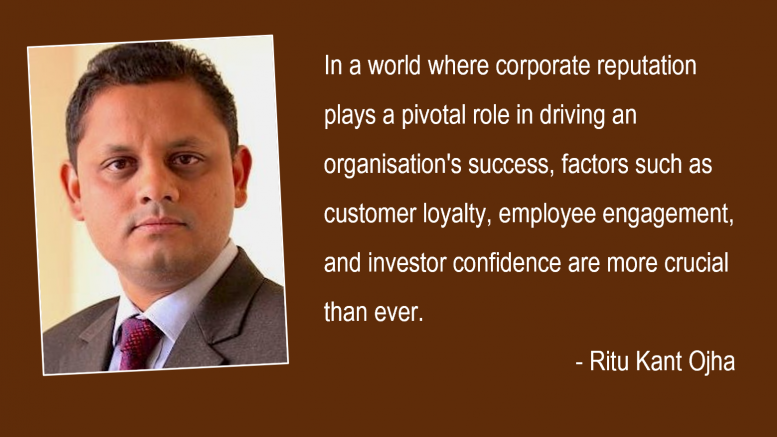Navigating today’s ever-changing business world is no small feat, and maintaining your brand’s reputation, crisis management, and public perception is more vital than ever. The secret weapon? Sustainability storytelling. But how can you, as communication leaders, harness this powerful strategy and make a lasting difference? In this article, we’ll explore three key areas of sustainability storytelling that can transform your brand and discuss valuable insights on how you can leverage its full potential. Prepare to elevate your organisation and lead the way in your respective industry.
Strengthening Corporate Reputation
In a world where corporate reputation plays a pivotal role in driving an organisation’s success, factors such as customer loyalty, employee engagement, and investor confidence are more crucial than ever. Sustainability storytelling emerges as a powerful strategy, enabling organisations to amplify their corporate reputation by embracing honest and transparent communication around their environmental, social, and governance (ESG) initiatives and achievements.
- Demonstrating transparency: Openly sharing information about a company’s sustainability initiatives, goals, and achievements demonstrates a commitment to transparency, which is highly valued by stakeholders. This transparency fosters trust and credibility, which are essential components of corporate reputation. By engaging in a consistent dialogue around sustainability and regularly updating stakeholders on progress, CXOs can build a strong foundation for a positive corporate reputation.
- Showcasing positive impact: Emphasising the tangible benefits of a company’s sustainability efforts, such as transitioning to renewable energy sources, implementing circular economy principles, and supporting local community empowerment programs, can help showcase the firm’s positive impact on society and the environment. By highlighting these accomplishments and weaving them into the company’s narrative, CXOs can significantly enhance their brand’s reputation and image.
- Aligning with stakeholder values: When businesses effectively communicate their sustainability initiatives, they showcase a deep understanding of their stakeholders’ concerns and priorities. By emphasising this alignment and adapting strategies to address the specific needs of customers, employees, and investors, CXOs can cultivate greater loyalty, engagement, and confidence, ultimately contributing to a reinforced corporate reputation.
Enhancing Crisis Resilience
Crisis situations pose a significant threat to a company’s reputation and public perception. However, purpose-driven storytelling can serve as a vital component in crisis communications and management, empowering CXOs with a solid foundation to navigate these challenges effectively and protect their organisation’s image.
- Demonstrating preparedness: Proactively communicating the company’s environmental and social stewardship and measures in place to prevent or mitigate potential crises can demonstrate that the business is prepared and proactive in addressing potential issues. This preparedness can help mitigate the negative impact of a crisis on the company’s reputation and instill confidence in stakeholders.
- Establishing credibility: By consistently communicating the company’s sustainability efforts and achievements, business leaders can establish a strong foundation of credibility with their stakeholders. This credibility can prove invaluable during a crisis, as customers, shareholders and investors are more likely to trust a company that has a track record of transparency and commitment to sustainability.
- Crafting a strategic narrative: Amidst a crisis, presenting a powerful and compelling sustainability narrative enables senior leadership to counteract negative publicity and uphold a positive perception among key players. By emphasising the company’s unwavering commitment to sustainability and responsible business practices, CXOs can convey that their organisation remains steadfast in its pursuit of making a positive impact, even under the most challenging circumstances.
Creating Winning Perceptions
In today’s fiercely competitive business landscape, fostering a positive perception is crucial for organisational success. By leveraging the power of sustainability storytelling, CXOs can sculpt and sustain a distinguished brand image by humanising their company’s persona, setting it apart from rivals, and captivating stakeholders through inspiring, purpose-driven narratives.
- Humanising the brand: By showcasing powerful, transformative stories of individuals and communities profoundly touched by the company’s unwavering commitment to sustainability, a business can breathe life into its brand, forging deep emotional bonds with customers. This heartfelt connection fosters unshakeable brand loyalty and shapes an overwhelmingly positive perception of the organisation, positioning it as a true trailblaser in its field.
- Masterful Sustainability Narratives: For business trailblasers at the helm, sustainability storytelling becomes a formidable weapon to set their organisation apart from the competition, by illuminating their unparalleled approach to tackling pressing environmental and societal concerns. By shining a spotlight on the company’s groundbreaking strategies and unwavering dedication to creating lasting, positive change, top executives can propel their brand to the forefront of the industry. This commanding presence not only amplifies public admiration but also fuels robust stakeholder engagement, securing the organisation’s position as an undisputed industry leader.
- Connecting with Stakeholders through Compelling Storytelling: As forward-thinking leaders, weaving captivating stories that highlight the organisation’s sustainability journey is essential to engaging and inspiring stakeholders. These meaningful narratives resonate with audiences, fostering a deeper appreciation of the company’s values and purpose. By adeptly connecting with stakeholders through sustainability storytelling, top executives can bolster a positive perception of their brand, reinforcing their organisation’s success in the marketplace.
In the era of increased environmental and social awareness, sustainability storytelling has emerged as a potent tool to enhance corporate reputation, build crisis resilience, and create winning perceptions. By embracing sustainability storytelling and integrating it into their organisation’s overall communication strategy, the senior management can unlock the future of their brand and drive long-term success. The key lies in understanding the power of storytelling and leveraging it to demonstrate transparency, showcase positive impact, and engage stakeholders in meaningful ways. By doing so, organisations can not only stay ahead in the competitive landscape but also contribute to a more sustainable and prosperous future.
The views and opinions published here belong to the author and do not necessarily reflect the views and opinions of the publisher.



Be the first to comment on "Leveraging Sustainability Storytelling To Build Reputation, Crisis Resilience, and Winning Perceptions"